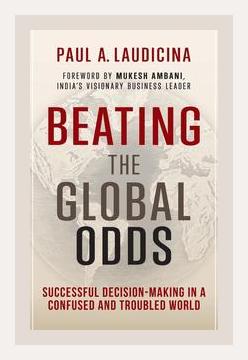Business StrategyCorporate Strategy
**
Introduction
“Beating the Global Odds” by Paul A. Laudicina is an insightful guide that aims to equip business leaders with practical strategies to navigate the uncertainties and complexities of the modern global business environment. The book is grounded in corporate strategy and offers a robust framework for successful decision-making amid volatile, uncertain, complex, and ambiguous (VUCA) world conditions. Through well-researched examples and actionable advice, Laudicina provides readers with tools to enhance their corporate strategies and make informed decisions.
Chapter 1: Understanding the Global Context
In the first chapter, Laudicina emphasizes the importance of understanding the global context in which businesses operate. He discusses macroeconomic factors, geopolitical trends, and social changes that influence corporate strategies.
Actionable Advice:
– Conduct Regular Environmental Scanning: Business leaders should routinely analyze global economic trends, political developments, and social shifts to anticipate changes that could impact their operations.
– Example: A company operating in multiple regions could set up a geopolitical risk assessment team to monitor global events continuously.
Chapter 2: Embracing Strategic Agility
Strategic agility is highlighted as critical for success. Laudicina argues that organizations must be flexible and adaptable to rapidly changing circumstances.
Actionable Advice:
– Foster a Culture of Agility: Encourage a corporate culture that values flexibility and quick decision-making.
– Example: Implement regular scenario planning exercises where teams simulate responses to various hypothetical situations.
Chapter 3: Building Robust Risk Management Systems
Risk management is essential in a destabilized world. Laudicina introduces a ‘risk radar’ approach to anticipate and mitigate potential risks.
Actionable Advice:
– Develop a Comprehensive Risk Management Framework: Create a system that identifies, assesses, and prioritizes risks, followed by implementing strategies to manage them.
– Example: A multinational corporation establishes a dedicated risk management committee to oversee and evaluate global risks regularly.
Chapter 4: Enhancing Decision-Making Processes
Effective decision-making is a core theme of the book. Laudicina stresses the need for structured yet flexible decision-making frameworks.
Actionable Advice:
– Implement Decision-Making Protocols: Adopt a systematic approach to decision-making that involves data collection, analysis, and stakeholder involvement.
– Example: A company could use the ‘DECIDE’ model (Define, Examine, Consider, Identify, Decide, Evaluate) to ensure comprehensive and transparent decision-making.
Chapter 5: Leveraging Technology and Innovation
Technological advancements and innovation are presented as pivotal for staying competitive. Laudicina discusses how businesses can leverage technology to drive growth and efficiency.
Actionable Advice:
– Invest in Emerging Technologies: Continuously explore and invest in new technologies that can enhance business operations and customer experiences.
– Example: An e-commerce firm invests in artificial intelligence (AI) for personalized customer service and efficient supply chain management.
Chapter 6: Cultivating Leadership and Talent
Leadership and talent management are crucial for navigating global challenges. Laudicina emphasizes the need for leaders to inspire and empower their teams.
Actionable Advice:
– Develop Comprehensive Leadership Programs: Create training and development programs that focus on building global leaders capable of managing diverse teams and complex situations.
– Example: A company implements a global leadership training initiative that includes cross-cultural workshops and international assignments.
Chapter 7: Creating a Sustainable and Ethical Business Model
Sustainability and ethical practices are increasingly important for long-term success. Laudicina argues for integrating sustainability into the core business strategy.
Actionable Advice:
– Adopt Sustainable Practices: Incorporate sustainability goals into business operations and performance metrics.
– Example: A manufacturing firm sets targets for reducing its carbon footprint and implementing green supply chain practices.
Chapter 8: Engaging with Stakeholders
Stakeholder engagement is necessary for informed decision-making and maintaining a positive corporate reputation. Laudicina highlights the importance of transparency and dialogue.
Actionable Advice:
– Implement Stakeholder Engagement Plans: Design and execute plans to engage with various stakeholders, including customers, employees, investors, and communities.
– Example: A company conducts regular town hall meetings and surveys to gather feedback from all stakeholder groups.
Chapter 9: Innovating Business Models
Laudicina discusses the need for continuous innovation in business models to stay ahead of the competition and meet changing market demands.
Actionable Advice:
– Explore New Business Models: Regularly assess and innovate business models to create value and capture emerging opportunities.
– Example: A traditional retailer transitions to an omnichannel strategy, blending physical stores with a robust online presence.
Conclusion
“Beating the Global Odds” offers a comprehensive guide for business leaders to navigate a complex and uncertain world. Paul A. Laudicina’s insights, distilled into actionable advice, emphasize the importance of strategic agility, robust risk management, effective decision-making, leveraging technology, cultivating leadership, sustainability, stakeholder engagement, and business model innovation. By implementing these strategies, organizations can be better prepared to face global challenges and seize opportunities in a turbulent environment.
Key Takeaways:
– Be Proactive: Regularly scan the global environment to stay ahead of potential disruptions.
– Stay Agile: Foster a corporate culture that values flexibility and quick adaptation.
– Manage Risks: Develop a thorough risk management framework to mitigate potential threats.
– Make Informed Decisions: Use systematic decision-making processes to navigate uncertainties.
– Leverage Technology: Invest in technology and innovation to drive growth.
– Empower Leadership: Cultivate leaders who can manage global challenges effectively.
– Adopt Sustainable Practices: Integrate sustainability into core business strategies.
– Engage Stakeholders: Maintain open and transparent communication with stakeholders.
– Innovate Continuously: Regularly reassess and innovate business models to stay competitive.
By following these principles, business leaders can make successful decisions and thrive in a confused and troubled world.
